On Saturday, July 20, I attended a presentation at The Walt Disney Family Museum titled: Learning from Walt with Rolly Crump. Disney Historian Jeff Heimbuch stopped by to moderate an informal talk with Rolly on what it was like to work for and learn from the greatest creative genius of all time, Walt Disney.
When Rolly was first offered a job with Disney, he was working as a dipper in a ceramic factory. He was head dipper, in fact, mainly because he was the only dipper. His salary was $75 a week, and Disney was offering him $30. Not sure if he’d be able to deal with making less than half of what he was used to making, he asked for a night to sleep on it. His mom reminded him that working for Disney was his dream, and to just go for it. Rolly took the job, and to supplement his income he worked making sewer manholes on the weekends.
Rolly was the last “in-between” hired for Peter Pan. Early in the talk he shared some of his fun drawings with us.
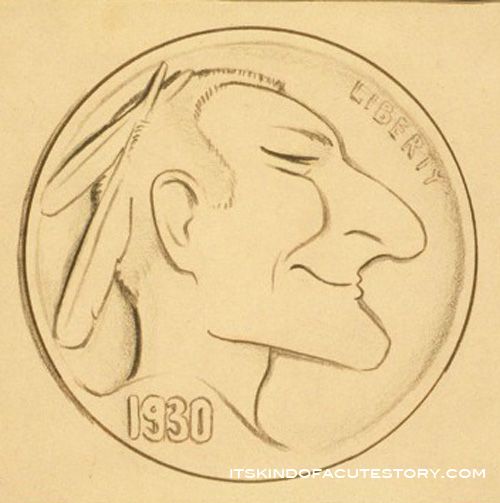 |
| A Rolly Penny! Photo courtesy of Jeff Heimbuch and Rolly Crump |
Aside from drawing, Rolly was also a fan of lifting weights at the Studio Gym. Proud of his physique, he shared a photo that demonstrated just how adept he had become. He also showed us a drawing of how he chose his outfit each morning.
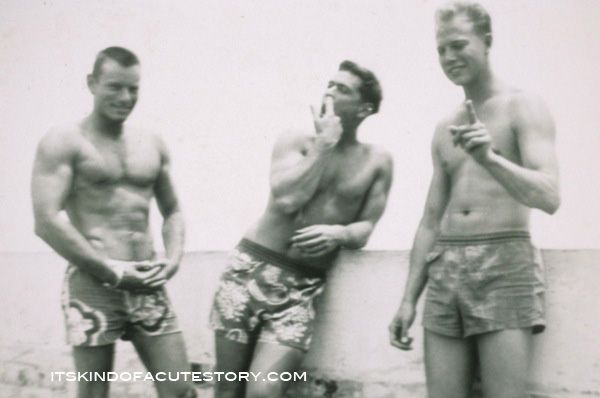 |
| You go, Rolly! Photo courtesy of Jeff Heimbuch and Rolly Crump |
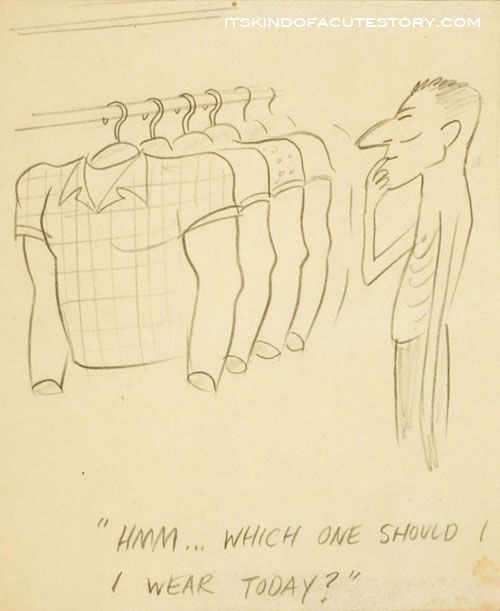 |
| Photo courtesy of Jeff Heimbuch and Rolly Crump |
One day fellow future Disney Legend Frank Armitage brought a mobile he built into the office, and Rolly became fascinated with it. Rolly had no idea what a mobile was at the time, so Armitage told him to visit the Studio Library and look up Alexander Calder (Calder was an American sculptor perhaps best known for inventing the mobile). Rolly did just that, and found himself building them on the weekends, when he had time off from his second job. Rolly even won over the Studio grouch by giving him a mobile he had created.
 |
| A mobile Rolly built Photo courtesy of Jeff Heimbuch and Rolly Crump |
Rolly picked up different art projects from his co-workers. For a while, he painted on rocks. Then one day he noticed something another future Disney Legend he worked with had created: a propeller. Wathel Rogers had taken the clip off of a pencil and made a little propeller out of it. Rolly constantly bugged him as to how he did it, but Rogers never told him. Finally, one day, Rogers offered to divulge his secret for the price of… one penny. Rolly happily paid, and Rogers advised him, “You use a ballpoint pen to make the dent, so the dent is smooth.” Rolly credits his propellers with changing his life. Years later when they were looking for people to join WED Enterprises (WED, which are Walt’s initials, was the early name for WDI, or Walt Disney Imagineering), Ward Kimball brought up Rolly’s name. Walt remembered those clever propellers, and Rolly was eventually transferred over.
WED
Walt Disney decided to pair Rolly with yet another future Disney Legend, Yale Gracey, to work on concepts for the Haunted Mansion. The two set up their own little studio, and took full advantage of the creative freedom they were granted. All sorts of crazy and spooky artifacts soon filled the area, to the point where the janitorial staff had requested the lights be left on at night. Soon after receiving said request, Rolly and Gracey came up with an idea. They rigged some of the figures to activate via an infrared sensor one night, then went home. The next morning when they came in, all of the figures were still going off, and there was a lone broom lying on the floor. Later that day they were informed that janitorial would no longer be cleaning their studio.
Rolly then told us about a few of the concepts they created for the Mansion. Yale discovered a book called The Boy Mechanic, and in it read about a visual effect from the mid-1800s known as the “Pepper’s Ghost Effect.” The simple effect utilized light and glass to reflect images, giving them a ghostly appearance. The two then came up with a creepy storyline to take advantage of this visual trickery. An old sea captain who murdered his wife drowns at sea, returns home, and is attacked by the spirit of his shrieking bride.
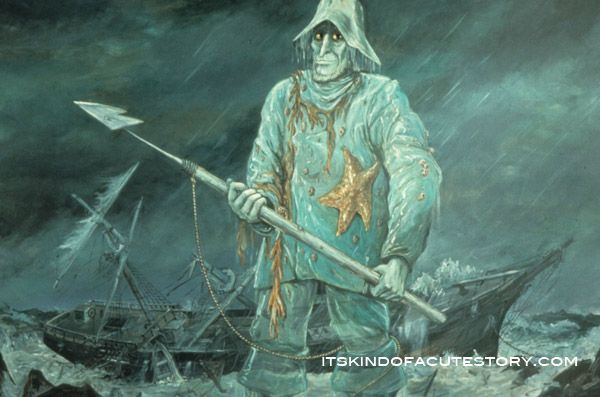 |
| The Sea Captain Photo courtesy of Jeff Heimbuch and Rolly Crump |
After tales of the Haunted Mansion, Rolly switched to a less scary gear and discussed his work on the Enchanted Tiki Room. The original concept for the Tiki Room was a restaurant featuring mechanical birds that would entertain the diners. Walt assigned Rolly to create some Tikis for the pre-show area out front, only there was one problem. Rolly didn’t know the first thing about Tikis. Of course he still said okay to Walt, but then went to the library and found a book called Voices on the Wind: Polynesian Myths and Chants. The book was a treasure trove of information for Rolly. He then found a book called Oceanic Art that detailed the sculptures, and he referenced it throughout his Tiki creation process. As we all know, the restaurant idea was scrapped, but the Tikis remained. According to Rolly, the Tiki Room was conceived, designed, and built within 90 days. One of the many benefits of working with Walt!
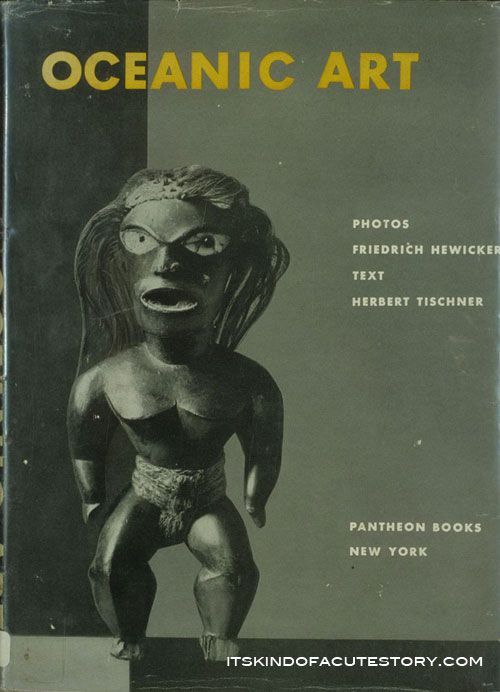 |
| The book Rolly used to study Tikis Photo courtesy of Jeff Heimbuch and Rolly Crump |
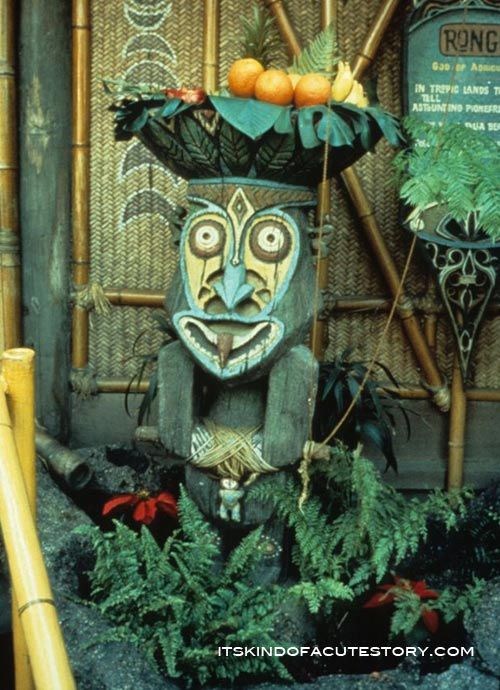 |
| Rongo, god of agriculture Photo courtesy of Jeff Heimbuch and Rolly Crump |
Another part of Adventureland Rolly had a hand in was the Bazaar. In 1961, it wasn’t very nice to look at, nor was it bringing in much money. Rolly was tasked with sprucing it up. And spruce it up, he did.
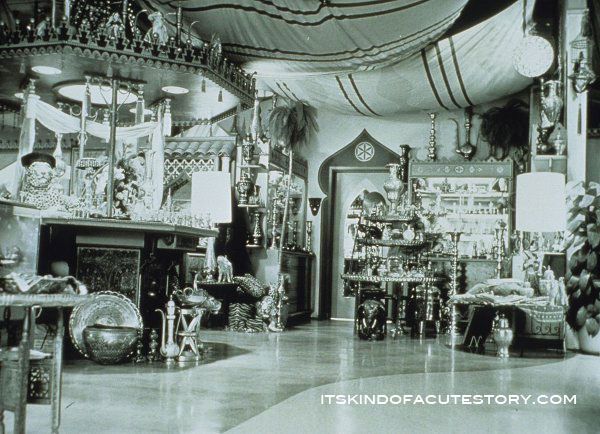 |
| Adventureland Bazaar after Rolly fixed it up Photo courtesy of Jeff Heimbuch and Rolly Crump |
While work was underway for the pavilions at the 1964/65 New York World’s Fair, Rolly was working on a mechanical orchestra to adorn the queue of Ford’s Magic Skyway. “Maybe you should make them [the instruments] look like car parts, being the Ford pavilion and all,” Walt said to him. Rolly loved the idea, and immediately sought out WED’s resident mechanical mastermind, Bob Gurr. They went through a catalog of Ford parts, and began to pick ones that could be cut up or manipulated to look like instruments. The end result was quite good.
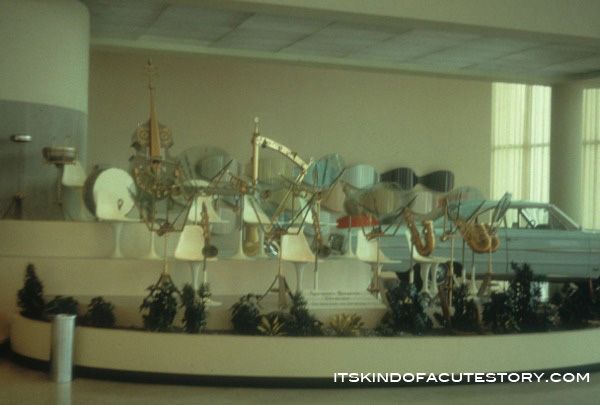 |
| Car Part Orchestra Photo courtesy of Jeff Heimbuch and Rolly Crump |
The most famous piece Rolly did for the Fair, however, would be done for the Pepsi-Cola Pavilion. Pepsi wanted to do a salute to UNICEF, so Walt wanted to do “a little boat ride,” and he recruited Rolly to create its marquee. Upon hearing what Walt had in mind, Rolly was delighted, as it basically sounded like a tower of mobiles. He soon assembled what would become one of the most iconic structures of the Fair, The Tower of the Four Winds.
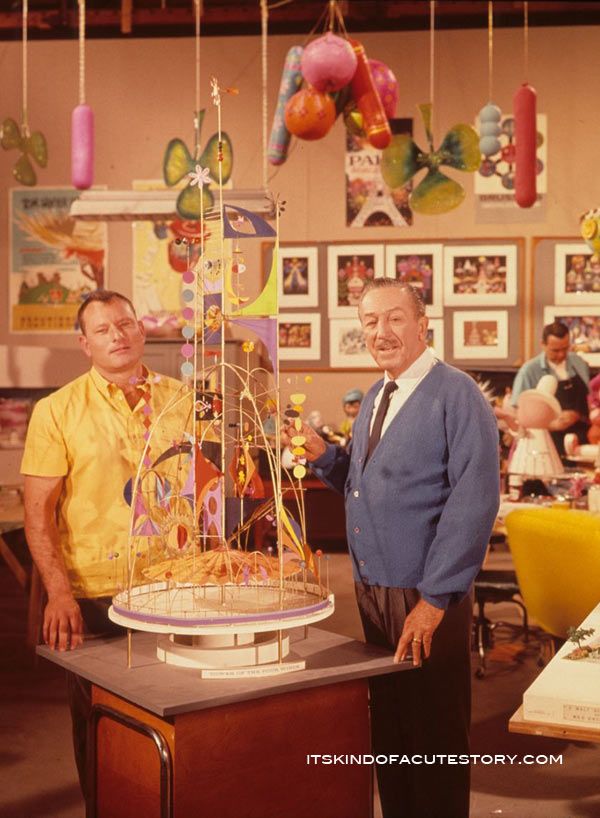 |
| Rolly with Walt and the model of the Tower of the Four Winds Photo courtesy of Jeff Heimbuch and Rolly Crump |
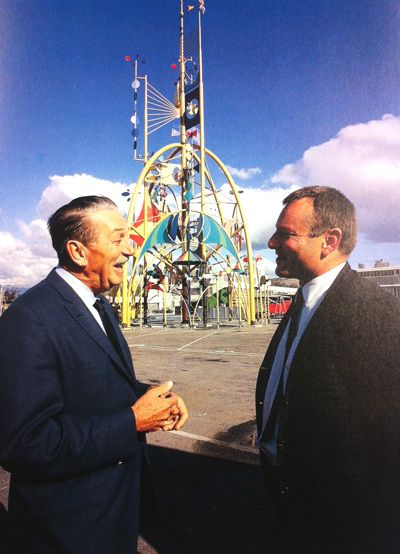 |
| Walt and Rolly in front of the actual Tower of the Four Winds Photo ©Disney |
Rolly also worked on the “little boat ride” itself, which would become known as it’s a small world. Walt recruited Mary Blair to work on the attraction, which immediately made Rolly excited. He was a huge fan of Blair’s work, and somewhat idolized her. In fact as a tribute to Mary Blair, Rolly made sure a little doll wearing her favorite outfit and sporting short, blonde hair made its way onto the ride. The doll is still there today, in Disneyland’s it’s a small world.
 |
| Rolly with Mary Blair Photo courtesy of Jeff Heimbuch and Rolly Crump |
The program ran a bit long, but no one seemed to mind, as Rolly’s stories were so engaging. Jeff Heimbuch did a good job navigating the pace of each story by providing accompanying photos with Rolly’s words. He also reminded Rolly to tell the audience about any tidbits he may have forgotten. Rolly’s talk wound down with a few post-World’s Fair projects. The first of which was getting it’s a small world relocated to Disneyland. The Tower of the Four Winds, which Rolly didn’t care for since engineers had to dramatically alter it to withstand the elements, was not going to make the trip. It met a grizzly fate, getting cut up into two-foot lengths and tossed into the ocean.
After the World’s Fair, and the relocation of Small World, Imagineers resumed work on projects that they had been involved with prior to the Fair. For Rolly, that meant the Haunted Mansion. He quickly realized that most folks were expecting the Mansion to be a typical haunted house ride. Rolly did not want it to be a house of spooky clichés, so he began sketching as many weird characters and set pieces that he could think of.
 |
| Museum of the Weird séance room Photo courtesy of Jeff Heimbuch and Rolly Crump |
One day Walt saw a bunch of the strange stuff over in Rolly’s area. No one seemed to know what he was doing, so Walt approached Rolly and asked, “Okay, what are you working on, Rolly?” Rolly replied, “ Honestly, I don’t know!” Walt told Rolly how weird all of the stuff was, and Rolly agreed. For the next few minutes Walt was trying to get Rolly to outline how all of those weird things were going to be utilized. Rolly didn’t have any definitive answers, so Walt eventually said, “That’s it, I’m out of here,” and left. The next morning Rolly went into the office a little early, only to find Walt waiting for him at his desk, wearing the same clothes he was wearing the day before. Walt told Rolly he didn’t get an ounce of sleep that night, because he couldn’t stop thinking of those sketches. A contrite Rolly apologized, but Walt just smiled and said, “No, no, don’t be sorry. I’ve got this idea for it.” That’s when he explained his idea for adding a little “Museum of the Weird” to the end of the Mansion, and Rolly loved it. Of course that idea never came to fruition, but Rolly did share several of the amazing sketches he created.
Rolly brought the presentation to a close with images from his work during the “New Tomorrowland” of 1967. Those images included a new central ticket booth, the Mickey Mart, the flowerbed at Tomorrowland’s entrance, and the Tomorrowland Terrace’s elevator bandstand. Rolly informed us that to create the pattern of flowers, it took just him, Bill Evans (head of Landscaping), and a shovel. Rolly created the pattern from his mind as they went, and the two planted each and every flower themselves.
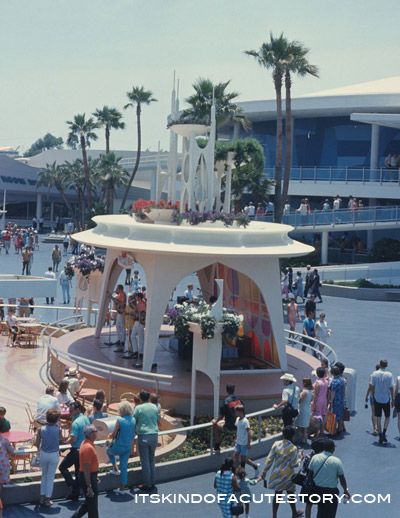 |
| Tomorrowland Terrace elevating stage Photo courtesy of Jeff Heimbuch and Rolly Crump |
With that, Rolly wrapped up his talk and fielded a few questions from the audience. It was after the Q&A that the grateful crowd responded with a standing ovation.
I want to thank Rolly and Jeff Heimbuch for the outstanding presentation. Jeff is a good friend of mine, but I thoroughly respect him as a peer, and the work he put into this program should not go unappreciated. I also want to say thanks to Jeff and Rolly for providing me with several of the photos used in their presentation to use in this recap. I would also like to point out that while I did take a copious amount of notes, this recap would not have been as comprehensive if I didn’t supplement my notes with information taken directly from Rolly and Jeff’s book, It’s Kind of a Cute Story.
After the standing ovation, the two adjourned to the lower lobby, where they met with fans and signed autographs. Unfortunately photos with the two weren’t allowed, but as my recaps always have photos of me with the presenters, I will just have to pull out some previously taken shots!
 |
| Me with Rolly at the Tiki Room |
 |
| Jeff and I hanging out on Buena Vista Street |
I hope you’ve enjoyed this recap as much as I enjoyed writing it. Once again, big thanks to Rolly Crump and Jeff Heimbuch for everything. If those two are ever making an appearance in your area, I strongly recommend going to see them.
Have been wondering about the connection between my favorite artist Alexander Calder and my favorite Imagineer Rolly Crump. Thank you for this information along with the rest! Loved reading it all and learned a lot!
ReplyDelete